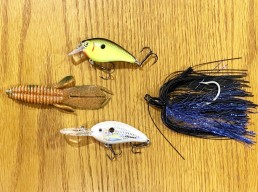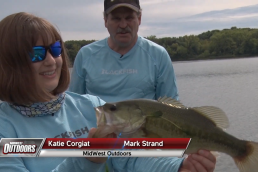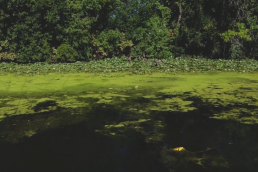Summer Main-Channel Largemouth Bass
SHARE THIS POST
As the dog days of summer hit the Mississippi River, fishing can get difficult for bass. Larger fish that seemed to be next to every flooded bush in spring now become scarce. Five-fish limits drop from the low 20-pound range down to 14 or 15 pounds, with most anglers catching limits in the 11- to 12-pound category. So, what happened to those fish, other than dropping their eggs during the spawn?
The short answer is, they spread out. Spring spawns concentrate the bass in shallow waters where anglers can get at them easily, but during summer, the fish spread out to feed or find refuge from the backwaters heat. Seasonal bass movement is better understood in reservoirs and lakes than in the Mississippi River. The river typically does not have stable habitats found in most lakes. Changes in flow and water level occur every few hours on the river, forcing anglers to continuously watch the conditions and change tactics accordingly. However, a few habitats do not change as quickly with the flow changes.
Depending on what you are trying to accomplish, fish can be found more consistently if you head to the main channel and look for structure. If the weed fish are biting, they are usually larger than the main channel bass, but the main channel bass tend to be more consistent in biting than the temperamental bass in the shallow weeds.
The first choice is to look for shad and try to find schools of fish feeding on them. These areas usually produce numbers, but the bass tend to be smaller on average. This could be on a current seam, a ledge or quick drop-off. One of my favorite places to find shad is at creek mouths entering in the top half of the pool. If there is a hard river level drop occurring, these spots can be blockbusters. If the mouth has a fast drop-off under it, then you likely have a goldmine. This may be the exception on size as well, as larger bass can be caught on those drops, too.
To fish these spots, start with something aggressive, such as a squarebill crankbait or spinnerbait. If there are fish there, they are actively feeding, so these search baits will get you the information you need on whether to move on or slow down. If you get a few bites, then switch to plastics and work the area thoroughly, including the drop-off. There could be everything from bass to gar to white bass working the spot, so continue sorting through the fish.
Are you enjoying this post?
You can be among the first to get the latest info on where to go, what to use and how to use it!
If you can figure out what the fish are eating, better yet. I had a tournament win once, specifically because a bass regurgitated its dinner. They were eating crawfish that were coming out of the creek. Now, I was flipping 15 feet from another boat and consistently out-caught the other boat about 5 to 1. They could see the bait I was flipping, but the key was, these crawfish were up in the water column as the current pushed them downstream. My no-weight rig was sliding across the flooded timber and the bass were exploding out of the water. Details usually make the difference.
A second area to check is the wingdam that your walleye buddies are hitting. These spots, especially during low flows, can hold bigger fish. One of my favorites has a notch in the dam, which adds some variability to the structure. First, start with a crankbait, usually in shad color, to catch those super aggressive fish. You may have to get the walleyes out of the way to get to the bass. In my favorite pool, we get some bonus smallmouths on these spots as well.
Once the crankbait bite slows, switch to a Carolina rig or flipping a plastic. If you have that target spot, such as a hole or notch, that can be a limit filler. Another reason to start with the crankbaits is to “catch” the fish. Carolina rigs and other plastics can be frustrating because these fish tend to jump, regardless of size, and many stories have made about the one that got away. Treble hooks on your crankbait eliminate those issues.
Finally, work any logs or downed trees you encounter that have some current. Flipping a tried-and-true blue/black jig with pork will get you the heavy fish you want, although it may take all day to find a handful of fish. Usually, those fish will be larger, so the reward for the hard work proves out.
When summer arrives and the fishing slows, head to the channel to catch fish all day long. It could save your trip or even make memories of a lifetime.
MWO
SHARE THIS POST
Did you enjoy this post?
You can be among the first to get the latest info on where to go, what to use and how to use it!
Jeremiah Haas
As a full-time fisheries biologist on the Mississippi River, Jeremiah Haas is intimately tied to the outdoor resources surrounding the greater Quad Cities area and the Upper Mississippi River Basin. An accomplished hunter, fisherman and writer, Haas offers unique insight and perspective to MidWest Outdoors readers.



